The Team Group MP34 512GB SSD Review: Refining Phison's NVMe Workhorse
by Billy Tallis on May 15, 2019 9:00 AM EST- Posted in
- SSDs
- Storage
- Toshiba
- Phison
- M.2
- NVMe
- BiCS
- 3D TLC
- Team Group
- PS5012-E12
AnandTech Storage Bench - The Destroyer
The Destroyer is an extremely long test replicating the access patterns of very IO-intensive desktop usage. A detailed breakdown can be found in this article. Like real-world usage, the drives do get the occasional break that allows for some background garbage collection and flushing caches, but those idle times are limited to 25ms so that it doesn't take all week to run the test. These AnandTech Storage Bench (ATSB) tests do not involve running the actual applications that generated the workloads, so the scores are relatively insensitive to changes in CPU performance and RAM from our new testbed, but the jump to a newer version of Windows and the newer storage drivers can have an impact.
We quantify performance on this test by reporting the drive's average data throughput, the average latency of the I/O operations, and the total energy used by the drive over the course of the test.
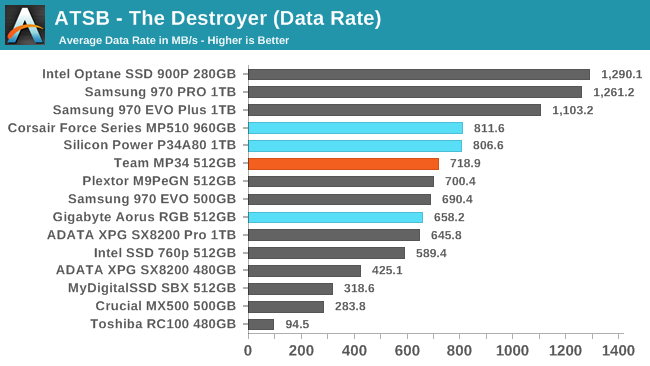
The overall performance of the Team Group MP34 on The Destroyer is the highest we've seen from a 512GB-class drive and a clear improvement over earlier Phison E12 firmware. We haven't tested the latest 500GB TLC drives from Samsung or WD, but even if Phison's latest firmware can't match them it is still competitive. The 1TB Phison E12 drives with older firmware are only about 12% faster overall than the 512GB MP34, so they clearly need to get updated.


The average and 99th percentile latencies on The Destroyer have both improved slightly for the MP34 compared to the Gigabyte drive with older firmware, but the 1TB class drives still have a larger advantage here than shown on the overall average data rate.
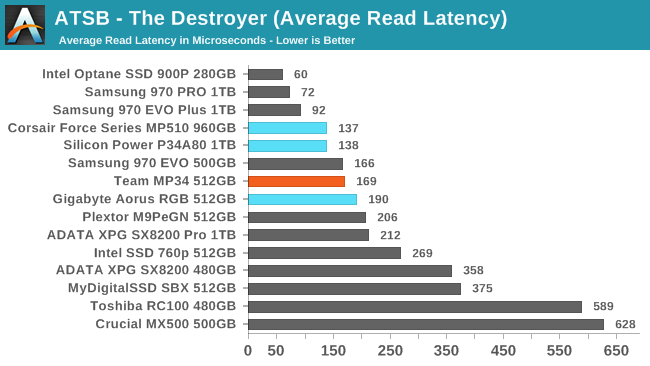
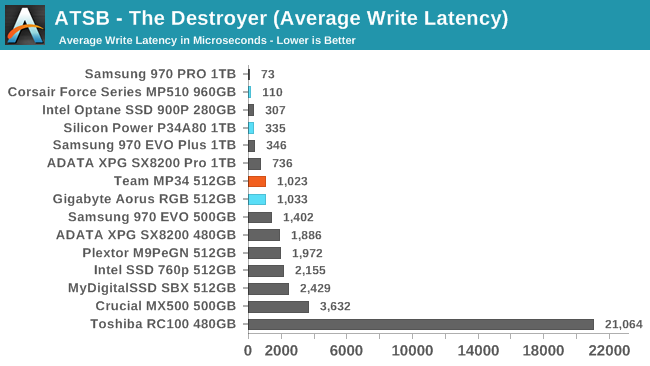
The new Phison E12 12.2 firmware seems to have a bigger impact on average read latencies than average write latencies. The Team MP34 is virtually tied with the Samsung 970 EVO for read latency, and Phison's existing lead in average write latency is barely improved.
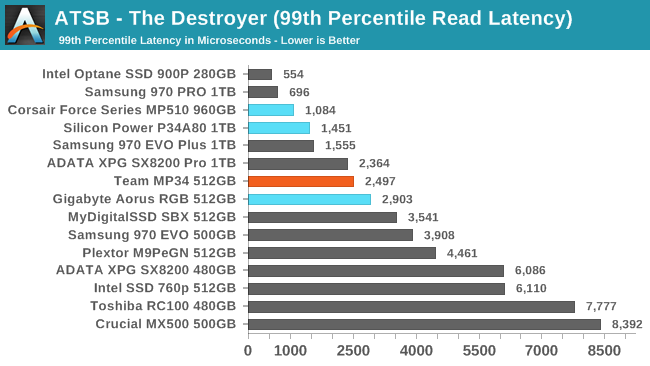
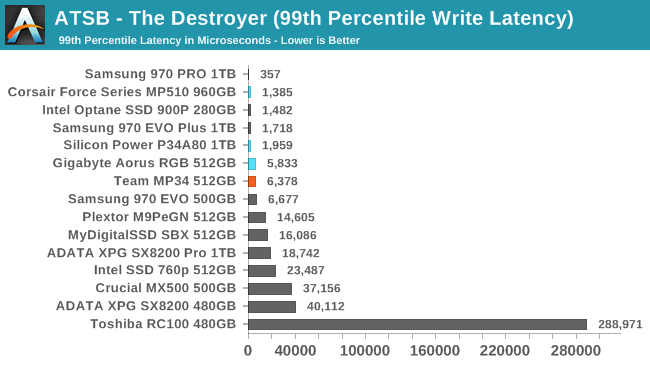
The 99th percentile read and write latency scores show roughly the same effects as the average read and write latencies: the new 12.2 firmware is a real improvement to read latency, but has minimal effect on write latency—not that Phison needed to work on the latter.
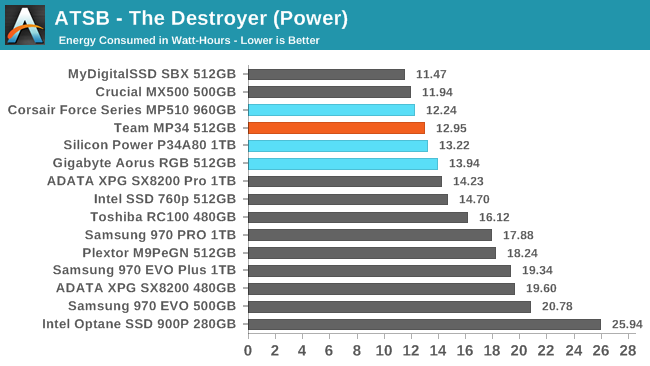
The Team MP34 uses less energy over the course of The Destroyer than any other 512GB-class high-end NVMe drive we've tested, but SATA drives and particularly efficient entry-level NVMe drives are still more efficient overall despite being significantly slower to complete the test.










17 Comments
View All Comments
Samus - Wednesday, May 15, 2019 - link
Why is the WD Black missing from all the benchmarks - even the recently reviewed SN750 is missing?I’m at a loss here, you specifically mentioned it on the first page of the article, along with Samsung, yet included all the Samsung drives...
futrtrubl - Wednesday, May 15, 2019 - link
Last page. "..if we had the chance to test the 500GB WD Black SN750"kobblestown - Wednesday, May 15, 2019 - link
FWIW, I just bought a 480GB Corsair MP510 and the firmware is reported as ECFM12.2. I don't know if it's available for update of older devices though.ssd-user - Wednesday, May 15, 2019 - link
Can you _please_ sort the SSD's by worst-case ("disk full") numbers rather than best-case ones? I generally really like your reviews, but your sorting is simply wrong, and some horribly bad ssd's end up looking much better than they are because of it.Particularly for things like the 99% latency numbers it is inane to sort by the best case, since the whole point is about near-worst-case latencies, and bad controller should simply not be given the benefit of the doubt.
Note that unless you actually trim the ssd, even an empty filesystem will act like a full one, since the ssd doesn't know which parts are used. So as far as the ssd is concerned, it's all full. So the argument that "most people have lots of room on their disk" is quite likely bogus to begin with, but possibly entirely irrelevant even if it were to be true.
Death666Angel - Thursday, May 16, 2019 - link
They are storted by worst-case, just in reverse. And if you use an SSD without an automatic trim OS, it's kinda on you, isn't it?ssd-user - Thursday, May 16, 2019 - link
Death666Angel: please learn to read. They are *not* "sorted by worst-case, just in reverse".Look at the "ATSB - Heavy (99th Percentile Latency)" graph, just as an example.
In particular, look at the ADATA XPG SX8200 Pro 1TB one. Look at how absolutely *HORRIBLE* the latency is for that.
Yet the idiotic and incorrect sorting shows it as the second-best SSD on that list, because the *best-case* latency when the drive is empty is reasonable. But once it gets full, and $
Anybody who thinks that that drive should be second-best on that list is incompetent.
ssd-user - Thursday, May 16, 2019 - link
Fat-fingered the response. The "and $" should be "and garbage collection happens, latency becomes horrid".Death666Angel - Saturday, May 18, 2019 - link
I still stand by "If you have an OS that uses GC as a valid algorithm, you desever all the crap you brought upon yourself." But have fun being a blast at parties! Learn to read fricking diagrams and stop bitching. Or start being the change you wanna see in the world!leexgx - Saturday, May 18, 2019 - link
the issue is only with the dramless drives when they are above 60-70% full witch you should avoid (the sandisk/WD blue recant controller is cida dramless but it has 10mb of ram on the controller it self witch seems to be enough to mitigate the lack of a full blown dram)ssd-user - Sunday, May 19, 2019 - link
Exactly. The point is that you should avoid those drives.Which is why they shouldn't show up at the top of the charts. They are not top drives, they are the dregs, and they should show up as such.